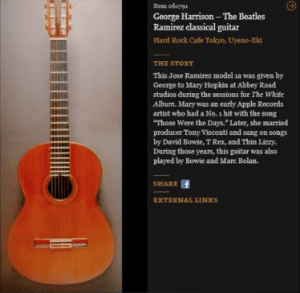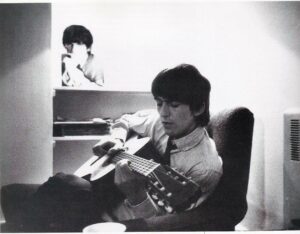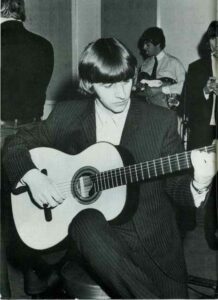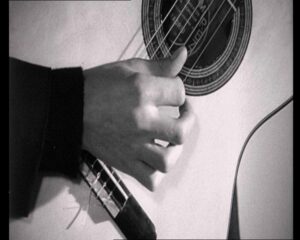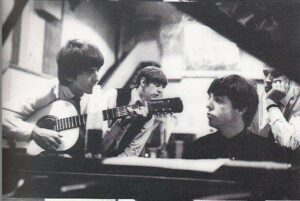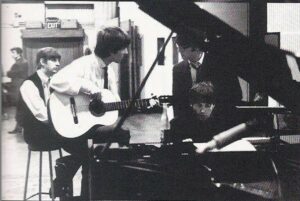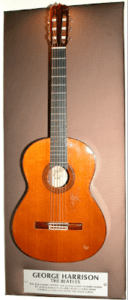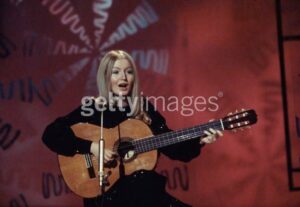We bring you an article written by our friend the musicologist Xosé Crisanto Gándara Eiroa, where he tells us one of the best-known anecdotes of the Ramírez Guitars. We hope you enjoy it as much as we do.
Your interior on the screens
On 14 September 1964, the film Qué Noche la de Aquel Día opened at the Imperial, Benlliure and Fuencarral cinemas in Madrid. The event attracted a large crowd of young people who were able to see their idols for the first time in Spain and was a real boost to their fame in our country. Although not a few editors and typographers in the Madrid press at the time named the Liverpool group with incorrect transcriptions of the name [the “Biter” or the “Batles”], the matter is relevant in terms of the identification of some of the instruments used by the quartet.
In one of the film’s sequences, the Beatles perform a ballad, And I Love Her, with acoustic guitar, bass, bongos and Spanish guitar. At one point during the performance, the camera stops on the latter, focusing on the inside of the body, allowing us to appreciate the instrument’s label: an image that would become part of the History of Pop Organology in the following decades.
A little over a month earlier, in the 8 August issue of the magazine Fonorama, an article appears in which the author [who signs his name “Nines”] includes a description and commentary on the film. In the final paragraph, he explains:
Antes de despedirnos queremos resaltar un detalle que nos hizo mucha gracia. Todos los conjuntos españoles tienen la manía de copiar los instrumentos de los conjuntos famosos extranjeros, Beatles, Shadows, etc., y para tal fin se empiezan comprando los Kim so instrumentos, guitarras «Gibson» o «Fender», sí es posible una «greche», y como amplificadores Vox, Selmer, Gibson, etc., pero en ésta película vimos un detalle francamente muy bueno. George Harrison, punteador del grupo, se endosa una guitarra española, de la que pudimos ver perfectamente su interior en las pantallas, la marca era una «Rodríguez» * y estaba fabricada en Madrid, sí amigos, mucho imitar. Los extranjeros, pero todos pudieron ver los sonidos tan fabulosos que George le sacaba a una guitarra de nuestro mercado nacional, y otro punto no le preguntéis, si esto fuera posible, el precio que le habría costado en su país, el precio que él habría pagado por ella es muy superior al precio de cualquiera de las guitarras, eléctrica o no, de fabricación extranjera. Ello nos demuestra que también en España tenemos cosas muy buenas.
(Before we say goodbye, we would like to point out a detail that made us laugh. All the Spanish bands have the mania of copying the instruments of the famous foreign bands, Beatles, Shadows, etc., and for this purpose, they start by buying the Kim so instruments, “Gibson” or “Fender” guitars, if possible a “greche”, and as amplifiers Vox, Selmer, Gibson, etc., but in this film, we saw a frankly very good detail. George Harrison, the band’s guitarist, endorsed a Spanish guitar, whose interior we could see perfectly on the screens, the brand was a “Rodriguez” and it was made in Madrid, yes friends, a lot to imitate. The foreigners, but everyone could see the fabulous sounds that George could get out of a guitar from our national market, and another point, don’t ask him if this were possible, the price it would have cost him in his country, the price he would have paid for it is much higher than the price of any guitar, electric or not, of foreign manufacture. This shows us that we also have very good things in Spain.)
Regardless of the dose of patriotic pride shown by the author, and regardless of the typographical errors contained in the text (* in reality the mark that can be read is Ramirez and not Rodriguez as quoted by the journalist), the most remarkable thing about this delightful paragraph is the mention of the brand of Spanish guitar in George Harrison’s hands, as well as the allusions to the presumed price “it would have cost him in his country”, as both are certainly far from the truth. But before addressing this point, it is worth bringing Ivor Mairants into the picture.
“Paul McCartney and Hank Marvin bought Ramírez flamenco guitars quite independently of one another to add an additional effect to their groups”
Ivor Mairants (1908-1998) was a Polish guitarist who had lived in London with his family since 1913 and was a member of various English musical groups for most of his life. In addition to writing several guitar methods, he opened on 1 September 1962, Oxford Street, his famous The Ivor Mairants Music Centre, an instrument shop of reference in the British capital, which included a wide range of Ramírez guitars, becoming the official distributor of the brand for the British market. In 1980 he published his autobiography, My Fifty Fretting Years, which is in fact a more than excellent journey through the history of the European guitar during most of the 20th century, narrated from the point of view of a performer and a first-hand connoisseur of all the intricacies related to the performance and construction of the instrument in its different stylistic aspects.
In one of the passages of this autobiography, Mairants provides us with a fundamental piece of information:
It [Ivor Mairants Music Centre, at the Oxford Street end of Rathbone Place, London] opened on 1 September 1962… The Beatles and The Shadows were then very strong and both Paul McCartney and Hank Marvin bought Ramírez flamenco guitars quite independently of one another to add an additional effect to their group.
We, therefore, have a Ramírez flamenco guitar, in the hands of Paul McCartney, and at a time close to the opening of the Mairants establishment. In fact, on 18 July 1963, during the recording sessions for the group’s second LP, With The Beatles, the quartet recorded their version of a song by Meredith Willson for 1957 musical The Music Man. The song is Till There Was You, and features the same instrumentation they would use seven months later for And I Love Her: acoustic guitar, bass, bongos and Spanish guitar. The style is that of a ballad with a Latin rhythm and the use of jazz harmonies, including a brilliant solo by George Harrison on the Spanish guitar.
Although it is not known what became of that copy, what seems very clear is the quartet’s [mainly Paul McCartney’s] interest in the use of the Spanish guitar [along with the bongos] in romantic ballads of this type, with an undeniable Latin flavour.
George Harrison’s interest in the Spanish guitar was already evident at least as early as February 1963. The 15th of that month’s issue of New Musical Express includes an interview with the group in which they express their tastes and preferences, in line with what was common at the time with youth magazines of this type. The list of questions includes the individual answers of each of them about their “Tastes in music”, and while John, Paul and Ringo mention rhythm-and-blues, gospel and country-and-western as their primary tastes, George Harrison’s answer leaves no room for doubt: “Spanish guitar”. In fact, his interest in the Spanish guitar, and especially in the figure of Andrés Segovia, would become clear in several later interviews. This circumstance would be made clear not only by the presence of records by the Spanish guitarist in his private collection but also by the use of techniques and postures typical of the Spanish guitar, which can be seen in various photographs and recordings.
And it was precisely in Spain that the acquisition of the most famous Ramirez in the world of pop music took place.
Dear old Klaus
It was during the Beatles’ first stay in Hamburg, between 17 August and the first weeks of December 1960, that they met Klaus Voormann. Voormann, a young Berlin student at the Hamburg School of Art, used to go to the venues in the Hanseatic city where the British band performed, with whom he forged a strong friendship that would last throughout the following decades. Voormann’s parents owned a villa in the Tenerife town of Los Realejos, which they used for holidays, and in the spring of 1963, the young Klaus was sent by his father to supervise the renovation work on the house, to which he was accompanied by his friend and former classmate from the Hamburg School of Art, the photographer Astrid Kirchherr.
This is where a fundamental character comes into the picture: Silvestre Álvarez Alemán. Silvestre was a classical guitar student who wanted to make a career as a performer. At that time he was studying at the Santa Cruz conservatory and took the opportunity to give private guitar lessons to young apprentices, including Klaus Voormann. In Silvestre’s personal archive there are some very interesting testimonies about this period, including some of the scores used during the classes, which include those that made up the syllabus of his work with Voormann.
Voormann used a Tatay guitar for his lessons, although Silvestre reminded him and insisted that sooner or later he would have to get a Ramírez if he really intended to devote himself to guitar playing.
It was against this background that an unexpected visit to the island took place. At the beginning of April Voormann receives a letter from Paul McCartney in which he expresses his intentions:
Dear Klaus, Hello – I wrote to Astrid for your address and she sent me the envelope – I think she’s angry with us, but then again she may not be. We thought that – as we’re going for a holiday on the 28th April we would all come out and see dear old Klaus in Tenerife, because we need the sun to keep us healthy… We’re doing fine here in England, our record is doing great (no. 3!!!!) and we’ve just recorded an L.P. We’ll bring it when we come. Do you mind if we come up to your house for a bit? And we can see dear old Klaus again after many years. Anyway we’re all looking forward to coming to Tenerife and If you wtite back, I’ll be able to send you the time and days when we’ll be there. Ta-Ta- goodbye etc…. Paul
The story is well known as it has already been told several times: Paul, George and Ringo arrived in Tenerife on 28 April 1963. They enjoyed the island with Klaus and Astrid – a good number of photos of their stay, mainly taken by Astrid, have survived – and left on 9 May for London, where they rejoined John to continue their budding musical career to stardom.
Naturally, Silvestre met and dealt with them during those days, and among the many anecdotes he remembers, the most relevant for the one we are dealing with here is George Harrison’s enormous interest in his guitar playing technique. He was particularly interested in the positioning of the instrument, and the use of the fingers of his right hand to play arpeggios, strumming, etc. In fact, of all the Beatles’ songs in which George Harrison uses this guitar -about fifteen-, it is precisely the arpeggios of And I Love Hermlos that show the “inspiration” for the classical touch of the Spanish guitar, a circumstance that is confirmed by some photographs from those dates in which the young musician from Liverpool holds the guitar resting on his right leg, while practising the arpeggios… in the purest classical style.
But it is now necessary to explain the context of the guitar’s acquisition and how it ended up in George Harrison’s hands.
Spanish instruments have always fascinated me
Voormann left Tenerife in the summer of 1963 for his family home in Berlin. The trip included a stopover in Madrid, which allowed him to spend a few hours in the city:
Zuvor musste ich aber noch für meinen Vater nach Teneriffa, um die Fertigstellung unseres Hauses dort zu beaufsichtigen. Als ich nach neun Monaten die kanarische Insel verließ, machte ich noch einen Abstecher nach Madrid, wo ich bei einem Bummel durch die schmalen Gassen der Altstadt einen Gitarrenbauer entdeckelte. Spanische Instrumente hatten mich immer schon fasziniert. Ich musste nicht lange überliegen und kaufte mir eine dieser schönen, handgearbeiteten Akustikgitarren.
(But first, I had to go to Tenerife for my father to supervise the completion of our house there. When I left the Canary Islands after nine months, I detoured to Madrid, where I discovered a guitar maker while strolling the narrow streets of the old town. Spanish instruments have always fascinated me. I didn’t have to wait long and bought one of these beautiful handmade acoustic guitars).
As he revealed in a personal interview with the writer of this article, “Gitarrenbauer” was precisely the Ramirez guitar shop, located at that time in Concepción Jerónima 2. Klaus had followed the advice of his teacher Silvestre and already had a shiny Ramirez guitar in his hands.
Silvestre’s personal archive contains several postcards that Voormann sent him from Berlin and London in the following months. In fact, after a few months in Berlin, he was invited by George and Ringo to the flat they shared at 57 Green Street, London, where he moved in the autumn of the same year. In one of the postcards sent from London, dated 23 March 1964, he explains in delightful Spanish:
Mi querido amigo Chicho, Yo escribo con felicidad en mi corazón porque yo soy seguro si tú tocas la guitarra todos los días. Tú debes escribir todo perfecto. Yo soy en Londres et tengo trabajo. Yo espero por mi licencia. Yo vivo juntos con los „BEATLES”. Es mui curiosso et bueno. Solamente hasta mi trabajo es seguro que no es necesario de hacer algún para ti en Londres? Yo puedo tocar el Sonata de Domenico Scarlatti. Adiós de Klaus.
(My dear friend Chicho, I write with happiness in my heart because I am safe if you play the guitar every day. You must write everything perfect. I am in London and I have a job. I wait for my license. I live together with the “BEATLES”. It’s very curious and good. Only until my job is sure that it is not necessary to do something for you in London? I can play the Sonata of Domenico Scarlatti. Goodbye from Klaus.)
At that time in the spring of 1964, around the time of the recording of the LP A Hard Day’s Night [which, it should be remembered, includes Ramirez’s guitar on the song And I Love Her], not only is Klaus practising one of the pieces that his teacher had taught him in Tenerife [the guitar transcription of one of Scarlatti’s sonatas], but George Harrison can see – and hear – his German friend’s performance in the Green Street flat.
But it is another postcard sent by Klaus from London to Tenerife, dated 8 July 1964, which provides us with the definitive data:
Mi querido amigo Chicho,
…
No tengo una guitarra haora. He regalado ella a George de los «Beatles».
Hasta pronto una carte de ti, tu grande amigo Klaus.(My dear friend Chicho,
(…)I don’t have a guitar now. I have given it to George from the “Beatles”.
See you soon a letter from you, your great friend Klaus.)
The recording of And I Love Her took place between 25 and 26 February 1964 at Abbey Road Studios. Two takes were taken on the first day, both with the quartet’s usual instrumentation of drums, bass and two electric guitars. It was during the 26 February session that the takes were taken in which the drums were replaced by bongos, John Lennon’s electric guitar by an acoustic, and George Harrison’s electric guitar by Voormann’s Ramirez. Remember that February 25th was George’s birthday, so it is quite tempting to hypothesise that Klaus gave the Ramirez to his friend on that particular day and that he played it for the first time during the recording session the following day. In any case, whatever the case, that day would be marked for posterity.
Instruments for rondalla
The organological characteristics of the guitar are also a chapter of interest. The label identifies it as an “instrument for rondalla”, which at the time served to distinguish those guitars built by external Spanish factories, and which underwent a quality review process before being labelled and distributed (In this case it has the handwritten inscription in ink “Fl 1 or CL1”, which leads us to suspect that it was a prototype of a Ramirez Studio guitar, further supported by the fact that only two copies are known. When we are going to launch a new Estudio model we make two similar prototypes that we give to our guitarists to try out to choose the one they like the most, then those instruments are sold on sale with other labels that are not those of the definitive model. We are investigating this point with Xosé to get more data). Instruments with this Rondalla label would serve as a way for students and amateurs to get started with a quality instrument before making the leap to a higher category instrument.
An identical example has been preserved in a private collection, the analysis of which has allowed us to determine the construction characteristics of the instrument. It is a “large” template guitar, whose measurements are as follows:
- Scale: 650 mm
- Lesser lobe: 27 cms
- Waist: 24 cms
- Larger lobe: 37’5 cms
- Length of the box: 50’5 cms
- Height of the sides: 6 cm
The bridge has rounded edges and includes a mother-of-pearl veneer in the area where the strings are tied. The fingerboard, with 19 frets, has an extension for the first three strings, which allows an extra fret to be added. The fan has eleven reeds, which explains why the thickness of the top is very thin. As for the woods, spruce for the top, cedar for the neck and headstock, and rosewood for the fingerboard.
In short, it is an example that faithfully follows the construction tradition of Spanish guitar making, with some unique features in terms of the number of fan ribs, the extension of the fretboard for the first three strings, and even the size of the insole.
Yellow Submarine
In the Hard Rock Café Uyeno-Eki in Tokyo, a Ramirez guitar is kept with a plaque mentioning that it was a gift from George Harrison to Mary Hopkins in 1968. Naturally, this circumstance triggered the necessary devices to set in motion an investigation to reproduce, as closely as possible, the context related to this instrument.
Mary Hopkins was a young 18-year-old Welsh singer who, in 1968, had been called upon by Paul McCartney to produce her first album at Apple Studios, founded by the Beatles that same year. As Mary Hopkins’ daughter Jessica Morgan mentioned to the author of this article in an interview, it was during one of these sessions at Apple Studios that George Harrison told Mary that he needed a good quality guitar. George left the studio and returned shortly afterwards with the Ramirez to give it to Mary on the spot.
In the young Welshwoman’s own words, she thought it was an enormously generous gift. She also remembered that it was the same day as the premiere of the film Yellow Submarine, i.e. 17 July of that year.
A photo of the guitar’s label was received from the Hard Rock Café in Tokyo, showing the guitar number, the year of construction, and the quality classification: it is a handmade 1st class guitar, with a cedar top and made in 1967. Thanks to these data it was possible to find out that the guitar was sent to Ramírez’s dealer in London at that time, Ivor Mairants, on 31 August 1967.
According to Jessica, Mary used the guitar for several years during her professional career. In 1997 she decided to put it up for sale and it was auctioned at Bonhams on 15 May this year, when it was acquired by the company that manages the Hard Rock Café. According to Jessica, her mother would like someone to be able to play it again one day, a way of keeping the memory of George Harrison and the spirit of another important Beatles-related Ramirez guitar alive.
Ramírez GH, The Beatles rock band and The George Harrison Guitar Collection
In the 21st century, George Harrison’s Ramirez has also had its own chapters. As Amalia Ramirez recounts, around 2003, the Ramirez distributor for Japan asked her if it would be possible to build a reissue of George Harrison’s Ramirez, given the demand that existed in Japan for the instruments used by the Beatles. This is how the Ramirez GH studio guitar was born.
The guitar has also found its own consumer niche in new technologies. On the one hand, the music video game The Beatles Rock Band, developed by Harmonix Music Systems, published by MTV Games, and distributed by Electronic Arts, from September 2009. Players can “play” Beatles songs in an environment similar to those of their original creation, with images of the instruments used by the Liverpool band, including the Ramirez. On the other hand, the application The George Harrison Guitar Collection, was developed for iPad at the behest of George Harrison’s son, Dhani. This application includes a number of guitars from the Liverpool musician’s collection, with their history, images, characteristics, etc., based on the originals kept in his Friar’s Park mansion.
By way of epilogue
This story is still far from complete, and no doubt new and relevant findings will contribute to developing it in the future. But I would not like to end without expressing my deepest gratitude to all those who have helped me with this research, especially Silvestre Álvarez Alemán, Fermín Hernández González, Amalia Ramírez, Cristina Ramírez Sanginés and Klaus Voormann.
Thank you for allowing me to be part of this fascinating story!
The article was written by: Xosé Crisanto Gándara Eiroa, Conservatorio Superior de Música da Coruña.
SOURCES AND BIBLIOGRAPHY
- Private archive of Silvestre Álvarez Alemán, Puerto de la Cruz, Tenerife.
- Digital Newspaper Library, BNE.
- Virtual Library of Historical Press.
- González Lemus, Nicolás. The Beatles in Tenerife. La Laguna: Nivaria Ediciones, 2010.
- Kirchherr, Astrid and Max Scheller. Yesterday. The Beatles Once Upon A Time. London: Plexus, 2007.
- “Life-lines of The Beatles.” New Musical Express 841 (1963): 9.
- Mairants, Ivor. My fifty fretting years. Newcastle: Ashley Mark, 1980.
- Voormann, Klaus. “Warum spielst du Imagine nicht auf dem weißen Klavier, John”. Munich: Wilhelm Heyne Verlag, 2003.


